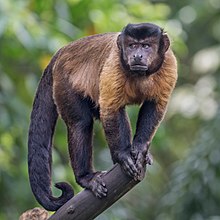| Tufted capuchin[1] | |
|---|---|

| |
| At River Wonders, Singapore | |
| Scientific classification | |
| Domain: | Eukaryota |
| Kingdom: | Animalia |
| Phylum: | Chordata |
| Class: | Mammalia |
| Order: | Primates |
| Suborder: | Haplorhini |
| Infraorder: | Simiiformes |
| Family: | Cebidae |
| Genus: | Sapajus |
| Species: | S. apella
|
| Binomial name | |
| Sapajus apella | |
| Subspecies | |
|
Sapajus apella macrocephalus Sapajus apella apella | |

| |
| Geographic range following taxonomy used by IUCN | |

| |
| Range of subspecies macrocephalus | |
| Synonyms | |
| |
The tufted capuchin (Sapajus apella), also known as brown capuchin, black-capped capuchin, or pin monkey, is a New World primate from South America and the Caribbean islands of Trinidad and Margarita. As traditionally defined, it is one of the most widespread primates in the Neotropics, but it has recently been recommended considering the black-striped, black and golden-bellied capuchins as separate species in a new genus, thereby effectively limiting the tufted capuchin to the Amazon basin and nearby regions.[1] However, the large-headed capuchin (S. a. macrocephalus), previously defined as a distinct species, has been reclassified as a subspecies of the tufted capuchin, expanding its range east to Peru and Ecuador and south to Bolivia.[3]
The tufted capuchin is an omnivorous animal, mostly feeding on fruits and invertebrates, although it sometimes feeds on small vertebrates (e.g. lizards and bird chicks) and other plant parts. It can be found in many different kinds of environment, including moist tropical and subtropical forest, dry forest, and disturbed or secondary forest.
Like other capuchins, it is a social animal, forming groups of 8 to 15 individuals that are led by an alpha or dominant male.
- ^ a b Groves, C. P. (2005). Wilson, D. E.; Reeder, D. M. (eds.). Mammal Species of the World: A Taxonomic and Geographic Reference (3rd ed.). Baltimore: Johns Hopkins University Press. p. 137. ISBN 0-801-88221-4. OCLC 62265494.
- ^ Boubli, J.P., Stevenson, P.R., Palacios, E., de la Torre, S., Ravetta, A.L., Messias, M.R., Carvalho, A.S. & Mittermeier, R.A. 2021. Sapajus apella (amended version of 2020 assessment). The IUCN Red List of Threatened Species 2021: e.T172351505A192594550. Sapajus apella - Black-capped Capuchin. Downloaded on 26 August 2021.
- ^ Lima, Marcela G. M.; Silva-Júnior, José de Sousa e; Černý, David; Buckner, Janet C.; Aleixo, Alexandre; Chang, Jonathan; Zheng, Jimmy; Alfaro, Michael E.; Martins, Amely; Di Fiore, Anthony; Boubli, Jean P. (1 July 2018). "A phylogenomic perspective on the robust capuchin monkey (Sapajus) radiation: First evidence for extensive population admixture across South America". Molecular Phylogenetics and Evolution. 124: 137–150. doi:10.1016/j.ympev.2018.02.023. ISSN 1055-7903. PMID 29545109. S2CID 4589398.
